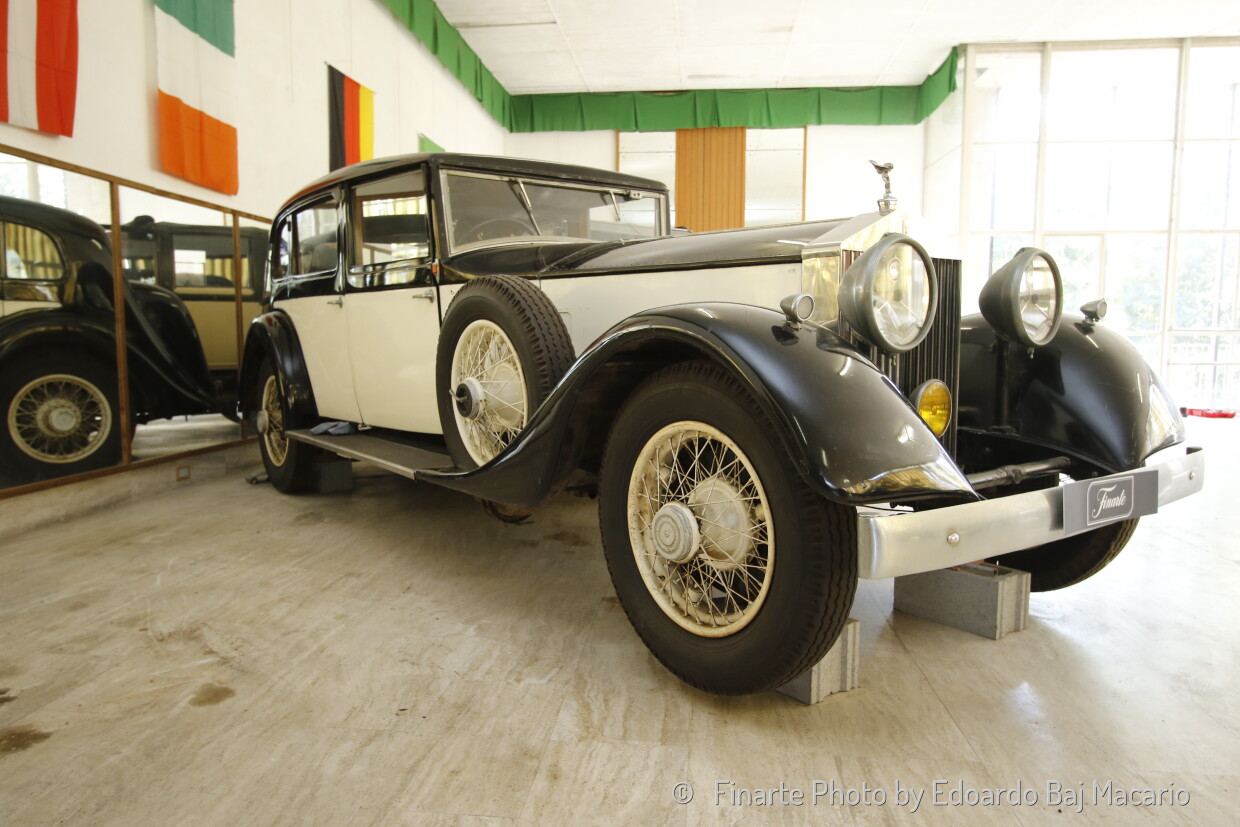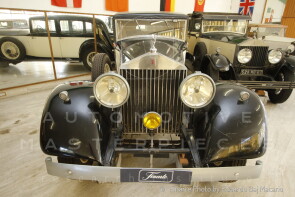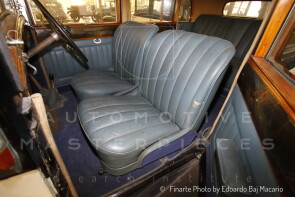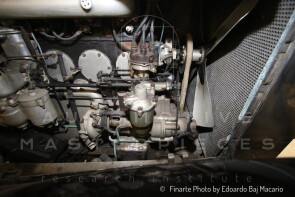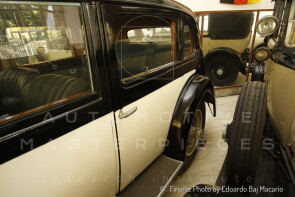
1930 Rolls Royce Phantom II
ON/OFF
Why am I an Automotive Masterpiece?
Rolls-Royce Limited, founded on March 15, 1906, by Charles Rolls and Henry Royce following a partnership, is renowned for its prestigious vehicles and has become over time the preferred supplier to the British Royal Family. One of its earliest models, the Silver Ghost (1907–1925), earned legendary status for its smoothness and operational fluidity, establishing the company's early reputation. The Silver Ghost proved tireless, completing a journey of over 14,000 miles nearly non-stop, creating the myth of "the best car in the world." Originally, Rolls-Royce referred to this model as the "40/50 hp," and "Silver Ghost" was initially the name of chassis no. 60551, registered AX 201, their demonstration example. Other 40/50 hp cars were also given names, but the title "Silver Ghost" was popularized by the press, and soon all 40/50 models were referred to by this name. Rolls-Royce did not officially recognize the name until 1925, with the launch of the “New Phantom” range. The New Phantom was Rolls-Royce's second 40/50 hp model, and the name Phantom was chosen as a nod to the "Silver Ghost," highlighting its "extraordinary stealth" and quietness compared to other vehicles of the time. When the New Phantom was replaced in 1929 by another 40/50 hp model, the successor was named Phantom II, and the New Phantom became commonly referred to as Phantom I. While Rolls-Royce themselves did not adopt the term "Phantom I" until the company's acquisition by BMW Group, the term was used informally in its time and is widely recognized by enthusiasts, concours events, and owner's clubs today. One of the innovations of the Phantom, introduced in 1925 to replace the now outdated Silver Ghost, was the development of its inline six-cylinder engine with overhead valves. Rolls-Royce has used the name Phantom from 1925 to the present day to designate a top-tier luxury vehicle aimed at an exclusive clientele. The Phantom series includes models from I (1925) to VIII (2017), as well as the Phantom Drophead Coupé (2007) and Coupé (2008).
The Phantom II was produced by Rolls-Royce from 1929 to 1935. It was the last automobile project completed by Henry Royce, assisted by A.G. Elliot and Ken Jenner for the engine, William Hardy and Bernard Day for the chassis, and Ivan Evernden for the bodywork. At the time, the head of the experimental department was Ernest Hives, and despite rigorous stress tests, the testers found almost no defects, which were still corrected by mid-January 1929. The official presentation took place in September 1929, shortly before Black Thursday on Wall Street: it could not have occurred at a more inopportune moment, and sales fell short of expectations. The chassis had a list price of £1,850, to which easily another thousand pounds for the bodywork could be added, making the car cost approximately four times the price of a mid-sized sedan of the era. The Phantom II competed in the luxury segment where competition from the large American car builders, the German Mercedes-Benz, and Bentley was fierce, as was Daimler, which was still the official supplier to the English court. The Phantom II was the third and last of Rolls-Royce's 40/50 hp models, replacing the New Phantom (Phantom I), and mounted an improved version of the inline six-cylinder engine with overhead valves. The new engine was a monoblock, unlike the Phantom I engine, which was a two-block engine with three cylinders each, and now had a new crossflow aluminum cylinder head. According to the manufacturer, it produced "sufficient" power, which was 108 hp at 2,300 rpm (some sources suggest around 120 hp). The pistons had a stroke of 139.7 mm and a bore of 107.9 mm, giving a displacement of 7,668 cc. It was the largest six-cylinder engine produced by Rolls-Royce. The engine was now bolted directly to the 4-speed manual transmission. Power was transmitted to the rear wheels using an open driveshaft, a hypoid bevel final drive, and a Hotchkiss drive, replacing the torque tube from a remotely mounted gearbox used on earlier 40/50 hp models. The chassis of the Phantom II was entirely new. The front axle was mounted on semi-elliptical leaf springs as on earlier 40/50 hp models, but the rear axle was now also mounted on semi-elliptical springs instead of cantilever springs. This, along with the drivetrain changes, allowed the frame to be lower than before, improving handling. The first series of Phantom II vehicles were equipped with a secondary frame supporting the body. The goal was to further isolate the passenger from road roughness by adding another element between the seats and the ground, but the weight penalty proved excessive, and the solution was abandoned in 1933. The braking system remained mechanical servo-assisted drums on all four wheels, and the Bijur centralized lubrication system from the Springfield-built Phantom I was included on all Phantom II chassis. Hydraulic shock absorbers could be adjusted via a lever on the steering wheel. Radiator shutters were manually operated until 1931. The standard wheelbase of the Phantom II was 3,800 mm. A "Continental" version, with a 3,700 mm short-wheelbase chassis and stiffer springs, was also available. All Phantom II rolling chassis were built at Rolls-Royce's factory in Derby. The factory in Springfield, Massachusetts, was closed when production of the US-market New Phantom ended in 1931. The left-hand-drive configuration was obviously popular in the United States, but some European customers also purchased left-hand-drive chassis, even though these were not regularly available outside the US. As was customary at the time, only the chassis and mechanical parts were made by Rolls-Royce. The body was made and fitted by coachbuilders upon request. Among the most popular were Park Ward, Brewster, Thrupp & Maberly, Mulliner, Carlton, Windovers, and Hooper. Outside the UK, cars were bodied in Australia by Martin & King, in Italy by Castagna, in Spain by Baltasar Fiol, in Germany by Erdmann und Rossi, in Sweden by Nordberg, in Belgium by Van den Plas, in the Netherlands by Van Rijswijk, in France by Saoutchik, Kellner, Binder, and Gaston Grümmer, and in the United States by Brewster and F.R. Wood. The aesthetics and performance of the Phantom II, significantly improved compared to the New Phantom, delighted the public. Despite this, positive press reviews, and a progressive price reduction policy, sales remained below production capacity. However, experimentation and project improvement continued year after year without interruption. The Phantom II is a familiar presence in popular imagination: it appeared in the films The Sorcerer's Apprentice and Indiana Jones and the Last Crusade. It was also the star of the 1964 film The Yellow Rolls-Royce. As a curiosity, the company Pocher, known for its detailed automobile models, released two 1/8th scale museum-level model kits of the Phantom II. Starting in 1933, following the death of co-founder Henry Royce, the red "RR" monogram on the radiators of Rolls-Royce cars was changed to black as a sign of mourning. A total of 1,681 Phantom II chassis of all types were built, including 278 "Continental" versions and 9 “Experimental” versions. Of these, 1,555 were right-hand-drive and 125 were left-hand-drive.
The Rolls-Royce Phantom II, chassis no. 87 GY, belongs to the fourth series (M2 series) out of eleven, that was produced in 1930. Originally bodied as a Sedanca de Ville, the car was created for exhibition at the 1930 Salon de l'Automobile de Paris. It was subsequently purchased by Barbara Hutton, heiress to the Woolworth empire. In the mid-1930s, the car underwent modifications, being converted from a Sedanca de Ville into a saloon. It is believed that further alterations may have been made to the rear section of the body, although Hoopers, the coachbuilder, confirmed that much of the vehicle remains as originally delivered. In 1937, the car was imported to Denmark, coinciding with Mrs. Hutton’s marriage to Count Haugwitz-Reventlow. It is thought to have remained there until 1974, when it reappeared at a Christie’s auction in Monza. At that time, chassis no. 87 GY was acquired by the car museum of the "Terme Idroterapiche delle Saline di Miradolo" spa complex, where it was displayed statically for nearly five decades. On November 14, 2022, the car was offered at the “Finarte 2022: Automobili da Collezione” auction, along with other vehicles from the museum's collection. The Phantom II appeared as a four-door six-light sports saloon with an integrated rear boot and a single side-mounted spare wheel. It was presented in a two-tone dark blue and white paint scheme, with an interior that matched its exterior elegance: finest quality light blue Connolly leather upholstery, deep blue carpets, and a grey West of England cloth headliner. The woodwork was finished in ebony, with all knobs and handles crafted from ivory. The car’s total mileage, despite its 90-year history, was approximately 70,000 km. After decades of inactivity, it required restoration work, yet it remained in good overall condition with well-preserved paint and interiors. During the auction, Phantom II, chassis no. 87 GY, was sold to a private collection.
